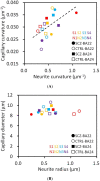Brain capillary structures of schizophrenia cases and controls show a correlation with their neuron structures
- PMID: 34083657
- PMCID: PMC8175464
- DOI: 10.1038/s41598-021-91233-z
Brain capillary structures of schizophrenia cases and controls show a correlation with their neuron structures
Abstract
Brain blood vessels constitute a micrometer-scale vascular network responsible for supply of oxygen and nutrition. In this study, we analyzed cerebral tissues of the anterior cingulate cortex and superior temporal gyrus of schizophrenia cases and age/gender-matched controls by using synchrotron radiation microtomography or micro-CT in order to examine the three-dimensional structure of cerebral vessels. Over 1 m of cerebral blood vessels was traced to build Cartesian-coordinate models, which were then used for calculating structural parameters including the diameter and curvature of the vessels. The distribution of vessel outer diameters showed a peak at 7-9 μm, corresponding to the diameter of the capillaries. Mean curvatures of the capillary vessels showed a significant correlation to the mean curvatures of neurites, while the mean capillary diameter was almost constant, independent of the cases. Our previous studies indicated that the neurites of schizophrenia cases are thin and tortuous compared to controls. The curved capillaries with a constant diameter should occupy a nearly constant volume, while neurons suffering from neurite thinning should have reduced volumes, resulting in a volumetric imbalance between the neurons and the vessels. We suggest that the observed structural correlation between neurons and blood vessels is related to neurovascular abnormalities in schizophrenia.
Conflict of interest statement
M.I. and M.A. declare a conflict of interest, being authors of several patents regarding therapeutic use of pyridoxamine for schizophrenia. All other authors declare no competing interests.
Figures




References
-
- Cipolla, M. J. Chapter 2 Anatomy and Ultrastructure. In The cerebral circulation, 3–14 (Morgan & Claypool Life Sciences, 2009). - PubMed
-
- Klein B, Kuschinsky W, Schröck H, Vetterlein F. Interdependency of local capillary density, blood flow, and metabolism in rat brains. Am. J. Physiol. 1986;251:H1333–1340. - PubMed
Publication types
MeSH terms
LinkOut - more resources
Full Text Sources
Medical

